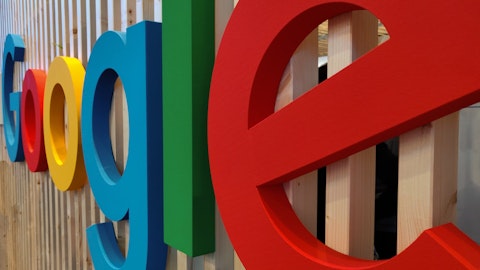Operator: Thank you. One moment for our next question. That will come from the line of Christopher Rolland with Susquehanna.
Christopher Rolland: Thanks for the question. Congrats on the quarter and closing the VMware deal. I guess, cost of capital has increased since VMware — since the announcement of the deal. And now that this is closed, I guess, does this affect how you look at your capital allocation strategy going forward? It sounds like you bounced — you bumped the divi here and you restarted your share repurchase now that it’s closed. Are you going to focus more on repurchases, or is it still same old Broadcom with acquisitions in mind as you delever?
Kirsten Spears: Always with acquisitions in mind, we’re continuing our share repurchase program that we promised. So that’s — we’re definitely buying back shares. Yes, as being Broadcom, we’ll delever quickly. So, we’ll keep everything in mind essentially.
Hock Tan: Chris, to expand a bit on that. We acquired VMware with part of cash because it took longer. So we got ourselves some part of cash. And with that flexibility, not only are we able to give dividends to the new shareholders from VMware side, we are continuing to complete the commitment we make to you, the shareholders, to — for the rest of fiscal — for the rest of calendar ‘23 to buy back that $7 million of shares out there.
Christopher Rolland: Great. Thanks. And maybe a quick follow-up. Thoughts on just why you didn’t offer next quarter in favor of the full year? And if you had any thoughts on the shape of revenue for next year, whether it’s back half loaded significantly or pretty linear?
Hock Tan: We just bought a company that’s pretty sizable. We are restructuring the business model and we’re changing, among other things, the business model to a subscription business model, as Kirsten said. And we see therefore that trajectory of the revenue — a sharp trajectory of growth for the revenue just by sheer conversion to subscription and the fact that we are also upselling a higher-value product. The combination of that and the new — in fact it’s company, we — makes it more — much more sensible, let’s put it this way, for us to be able to give you a full year number than a three-month guidance. Because spending — transition spending might slip, might accelerate, revenue might accelerate, might slip. And giving ourselves three months to tell you what it is, especially on a new environment to us, it’s not very, very, I call it — we are not being good to you guys, the shareholders.
But for the full year, I think we have hell a lot more confidence we will attain those endpoints at the exit.
Operator: And one moment for our next question. And that will come from the line of Toshiya Hari with Goldman Sachs.
Toshiya Hari: Hock, I had a question on the semiconductor business and specifically on the non-AI side of things for both networking and server storage connectivity. As you noted, you’re obviously going through a cyclical correction. Historically, you’ve had a pretty good understanding of where customer inventory is. And when we simply look at their balance sheets for the public companies, inventory is pretty elevated, particularly on the networking side. What is your interpretation of where inventory is for your products? And how should we think about the timing and pace of recovery as you look into 2024? Thank you.
Hock Tan: On our books, you can see inventory for our products is pretty damn good, right, especially compared to our peers, and that’s because we keep it tight. Out in customers, and we don’t sell through channels, we don’t sell much through channels. We usually do a lot of it direct to our logic customers. We feel they are in good shape, relatively speaking. We are still in good shape. Now, if you ask me, maybe server storage, that could be a little excessive, but not broadband and certainly not in networking. So overall, on our products, we still feel rather good about it. And the best indication is the level of our own inventory on our own books. But what we do see is customers are perhaps much more cautious about buying more stuff, not just because they have too much of my inventory, I think because they have too much of everybody else inventory out there.
We tend to see some caution in the way they choose to buy. Having said that, we’re still keeping to our lead times.
Toshiya Hari: And Hock, any comment on sort of the timing or the shape of the recovery in ‘24?
Hock Tan: If only I know. I mean, I’ll be speculating to say second half of ‘24 things will start looking better compared to the first half of ‘24.
Operator: And one moment for our next question. And that will come from the line of Karl Ackerman with BNP Paribas.
Karl Ackerman: Hock, I was hoping you may discuss the reason for divesting EUC and Carbon Black. And maybe more importantly, as you think about the growth rate off this $12 billion, Kirsten, could you discuss the opportunity you see in front of you as DRAM memory pooling brought in from the adoption of CXL within data centers that would seem to be a very big opportunity for VMware? Thank you.
Hock Tan: Yes. What was the first question again? Sorry. Okay. Why do I chose to sell End-User Computing and Carbon Black? Those are good assets. Let’s make no mistake. They are very sustaining. They are very stable, good assets. And why we chose to sell them is typically our playbook. We focus very much so on — in any acquisition where we see the biggest value for our business model. And basically, we then do not want to be distracted by noncore focus. And VMware for us is about core. It’s about data centers, it’s about core networks and core compute. And so, we’re now going to invest and focus our sales and R&D on those core areas of VMware Cloud Foundation. And to us, End-User Computing, Carbon Black, good assets as they may be, we prefer now to divest them.





